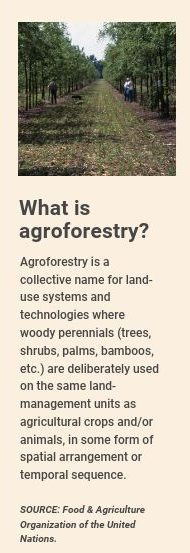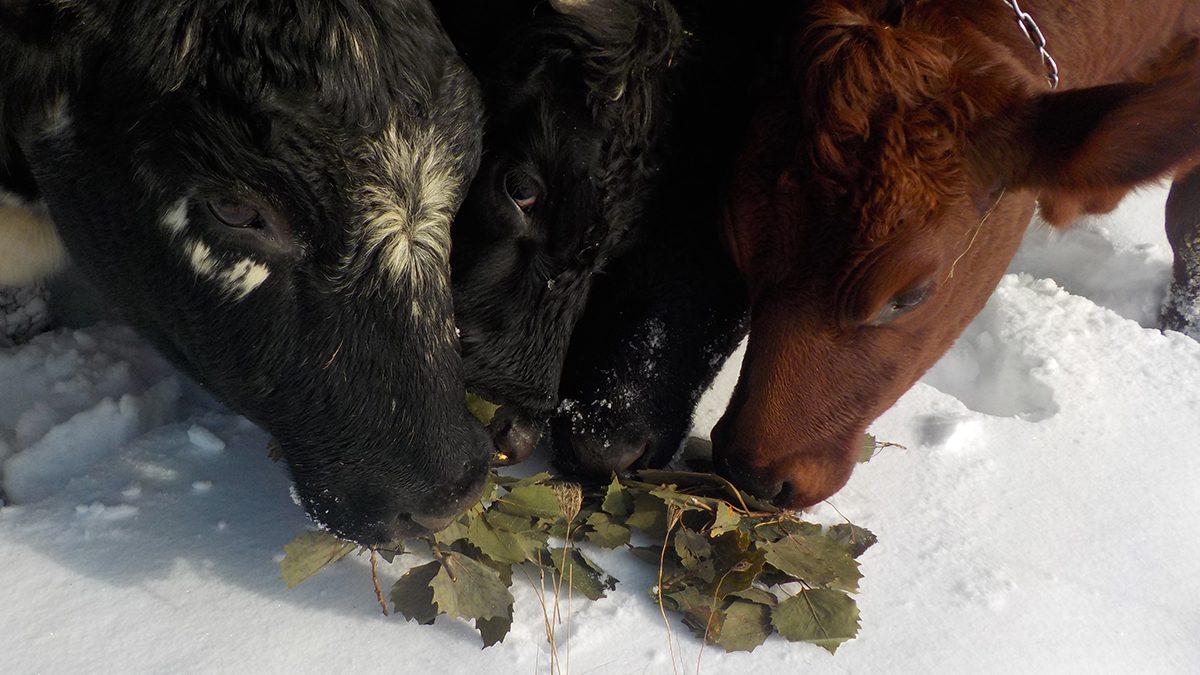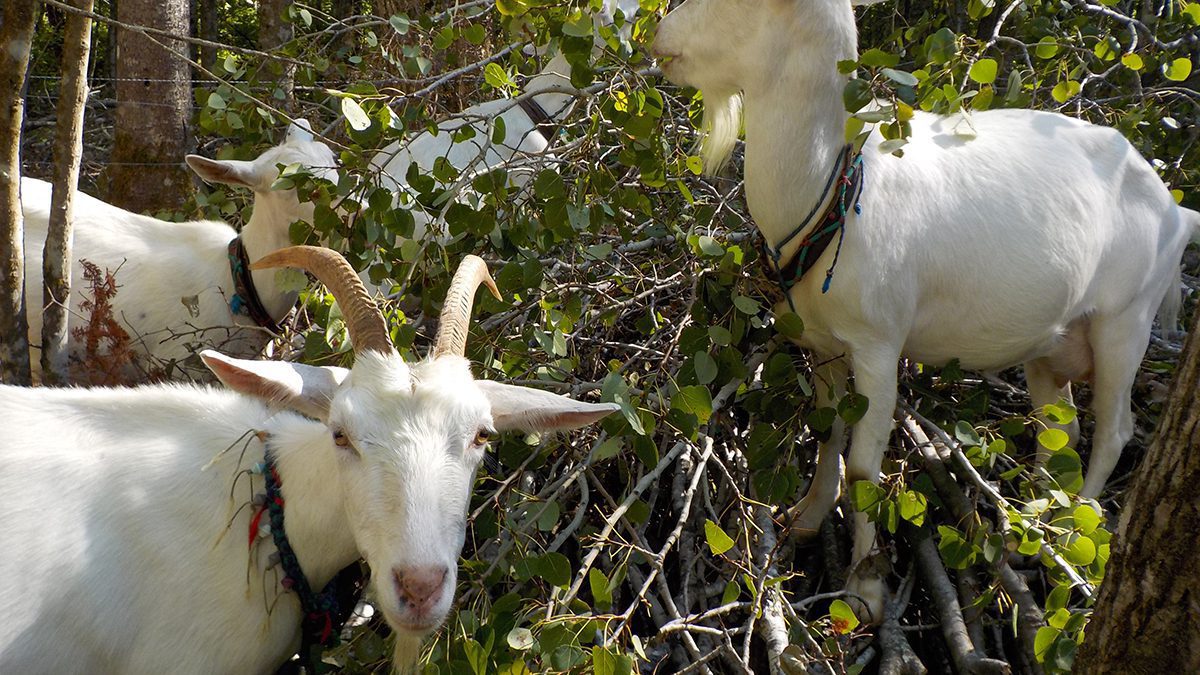Agroforestry, an age-old concept, could provide a path to Maine’s future. Part of the regenerative agriculture movement, it involves an integrated approach to cultivating trees with crops and – sometimes – livestock. These diversified farm systems nourish soil health and wildlife while offering more resilience in a warming world — locking up atmospheric carbon, absorbing floodwaters, and sheltering crops and animals from high winds and extreme heat.
“Diversity is really key to sustainability for small farms and the ecology of farms,” said vegetable farmer Max Boudreau of Winslow Farm in Falmouth. He sees many landowners and homesteaders “putting these principles into practice,” but said agroforestry is still “a foreign concept” in farm service agencies.

Being interdisciplinary, agroforestry challenges the siloed world of natural resource management. It is routinely ignored in college curricula and by technical service providers, said Meghan Giroux, an agroforestry researcher, technical service provider and practitioner in Vermont. Her nonprofit, Interlace Commons, seeks to fill that void by training farmers – including Boudreau – how to implement and maintain agroforestry practices.
Boudreau was one of the 20 farmers selected among 92 applicants from around the Northeast for a free, agroforestry “field consultancy” this year. Farmers are eager to learn about agroforestry’s potential to diversify income, and there’s growing consumer demand for its products – from nuts and uncommon fruits (like honeyberry and paw paw) to mushrooms and medicinal herbs.
Yet policymakers routinely tell Giroux there’s “no interest in agroforestry,” she says. “There’s no institutional will to move these practices forward primarily because people don’t understand them.”
The U.S. Department of Agriculture has supported agroforestry since the 1990 Farm Bill and does exceptional research, Giroux feels, but “a knowledge-exchange issue” prevents guidance from reaching most landowners. A network of trained farmers could help support and train peers – a process that happens informally, Boudreau says, in the permaculture community, a related landscape design approach modeled after natural systems.
Research has already demonstrated that no-till agriculture improves crop yields, reduces costs and improves soil health. Even more economic and environmental benefits could flow from cultivating crops in a layered, integrated mix of annuals and perennials more reminiscent of natural plant communities.
A good fit for Maine
Some of the more creative agroforestry approaches involve alley cropping (interspersing annual and perennial plants), forest farming, where potentially lucrative shade crops are grown in woodland settings, and silvopasture, which incorporates trees with pasture and forage.
Silvopasture holds the most benefit among all agricultural solutions for reducing atmospheric carbon, according to Project Drawdown, a research nonprofit. That could be good news for the nation’s most forested state. “We know trees grow really well here in Maine,” said Jesse Stevens, who runs a nursery and orchard in western Maine specializing in edible woody plants. Agroforestry could accelerate the state’s efforts to meet its ambitious climate goals.
Much of the research on silvopasture techniques in the Northeast has taken place at Cornell University’s Small Farms program, assessing the effects of adding trees to pasture areas or rotational grazing of livestock or poultry in woodland settings.

A scientific approach and commitment to conservation is essential, said Kate MacFarland, one of just two agroforesters at the USDA National Agroforestry Center, noting it can be “challenging if you go it alone,” because farm animals can damage woodland ecosystems if not moved regularly.
In agroforestry trainings, often done with agencies such as soil and water conservation districts, Natural Resource Conservation Service or Cooperative Extension, MacFarland works to get “farmers involved from the beginning,” typically having “those conversations on farms and in the woods,” where participants can see agroforestry practices at work.
To date, agroforestry has been driven largely by researchers, said David Fuller, University of Maine Cooperative Extension professional focused on agriculture and non-timber forest products. “The push needs to come from landowners but they have to be educated about the potential.”
It would help to have more coordination among those already doing agroforestry, Boudreau said. Maine could establish a northeastern equivalent of the Appalachian Beginning Forest Farmer Coalition, a network of landowners, researchers and representatives of both governmental agencies and nongovernmental organizations working to increase agroforestry production and build the skills of practitioners.
The Appalachian Coalition has brought in significant federal funding to help farmers in that economically challenged region grow native understory plants like edible ramps and medicinal herbs (such as ginseng, goldenseal and black cohosh). Cultivated, third-party verified forest herbs can command high prices from nutraceutical companies concerned with ethical product sourcing while helping reduce harvesting pressure on wild plants.
An agroforestry hub in Maine could gather experts and practitioners to determine what combinations of plant communities might work best here and what equipment might be needed. It could create a demonstration site and potentially even revive a subsidized state nursery, which Maine had for decades.
The coalition could also expand training to landowners and the agencies that support farmers. Ideally, Maine would fund an agroforestry extension agent to support the network, provide training, field questions from practitioners and educate consumers about uses of agroforestry crops.
The Maine Farmer Resource Network, established to support beginning farmers, has provided the state with significant returns. The number of farmers under age 34 more than doubled between 2012 and 2017. Now Maine needs to make a similar commitment to getting existing and new farmers engaged in agroforestry.
Fortunately, Maine’s new Climate Action Plan directly addresses this need, advocating “more widely available” technical support to help farmers adopt agricultural practices that can store carbon and increase climate resilience. The plan also recommends financial incentives to help farmers adopt more climate-friendly agricultural practices (with silvopasture arguably the friendliest of all).
Incentives could help motivate landowners, given the long time frame agroforestry demands. It can take 10 years to see the results of an installed food forest, said Jack Kertesz, who founded the Maine Tree Crop Alliance in 1983 and works as landscape coordinator for Maine Organic Farmers and Gardeners Alliance.
A strategic approach to agroforestry would likely offer Maine a high return on investment – boosting farm productivity while improving soil health, water quality, biodiversity, flood resilience and stored carbon.
Leadership is key, Kertesz said: “It will take vision to pull this off. I’m not sure we’ve seen boldness here much.” Yet he still finds cause for optimism: “Who would have guessed (decades ago) that organic farms would have succeeded?”
Resources
- Association for Temperate Agroforestry
- Appalachia Beginning Forest Farmer Coalition
- Guide to USDA Agroforestry Research Funding Opportunities
- Agroforestry: Enhancing Resiliency in U.S. Agricultural Landscapes under Changing Conditions
- Photo Guide to Northeastern United States Silvopasture
- Pennsylvania Agroforestry: Success in the Farm and Forest Mosaic
- SARE study in Maine of potential tree leaf fodder for livestock







